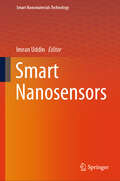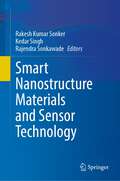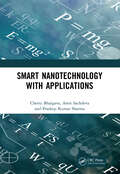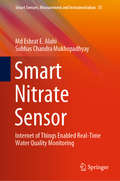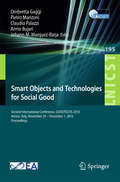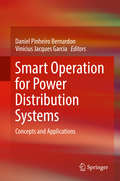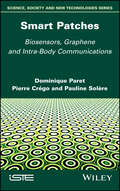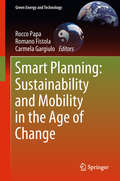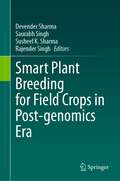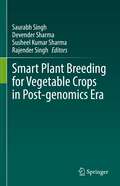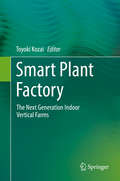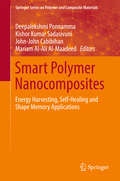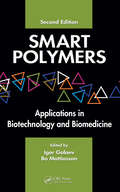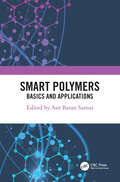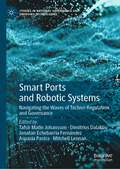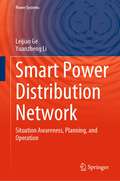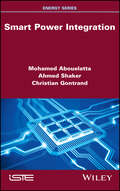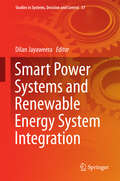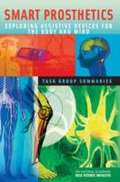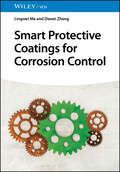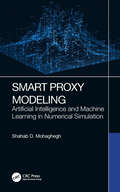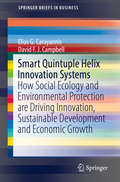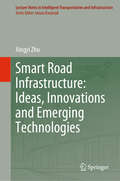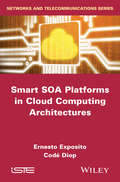- Table View
- List View
Smart Nanosensors (Smart Nanomaterials Technology)
by Imran UddinThis book serves as a comprehensive compilation of contemporary research conducted in the domain of nanosensors. The amalgamation of many elements within the emerging field contributes to the development of a useful collection specifically designed for inexperienced researchers in the domain of smart materials and nanosensor technologies. An adequate range of subjects has been incorporated into the present book. It includes enzyme-mimetic use of smart nanomaterials for enhanced biosensing applications, theranostic utilization of smart nanomaterials for targeted drug delivery, sensors for pollutant detection, and the utilization of smart nanomaterials in the development of biosensors for studying host-microbe interactions. Nanosensors have emerged as a promising avenue for various applications, including sensing in the fields of medicine, packaging, and heavy metal ion detection. Recent developments in the field of smart nanomaterials have led to significant advancements in the application of intelligent switches and sensors within the domains of agriculture, food production, and water treatment. The primary emphasis of this book is the study of the synthesis and fabrication processes involved in the production of smart materials, together with their application within the domain of sensor technology. The existing body of literature has two main categories: introductory textbooks that provide fundamental knowledge about the field and specialized publications that focus exclusively on certain subtopics within the domain of sensor technology. The existing material of the book makes it a complete reference resource that is well-suited for researchers in the area. It especially caters to advanced graduate students who are seeking senior graduate, MTech, and MS degrees in the subject of sensor technology. Additionally, this publication would function as an essential resource for researchers across diverse disciplines within the area of materials science who are aiming to propel the development of smart materials.
Smart Nanostructure Materials and Sensor Technology
by Rakesh Kumar Sonker Kedar Singh Rajendra SonkawadeThis book highlights the significance and usefulness of nanomaterials for the development of sensing devices and their real-life applications. The book also addresses various means of synthesizing 2D/3D nanomaterials, e.g., hydrothermal deposition process, electrospinning, Ostwald ripening, sputtering heterogeneous deposition, liquid-phase preparation, the vapor deposition approach, and aerosol flame synthesis. It presents an informative overview of the role of nanoscale materials in the development of advanced sensor devices at nanoscale and discusses the applications of nanomaterials in different forms prepared by diverse techniques in the field of optoelectronics and biomedical devices. Major features, such as type of nanomaterials, fabrication methods, applications, tasks, benefits and restrictions, and saleable features, are also covered.
Smart Nanotechnology with Applications
by Cherry Bhargava Amit Sachdeva Pradeep Kumar SharmaThis comprehensive reference text discusses advance concepts and applications in the field of nanotechnology. The text presents a detailed discussion of key important concepts including nanomaterials and nanodevices, nano-bio interface, nanoscale memories, and semiconductor nanotechnology. It discusses applications of nanotechnology in the fields of aerospace engineering, cosmetic industry, pharmaceutical science, food industry, and the textile industry. The text will be useful for senior undergraduate and graduate students in the field of electrical engineering, electronics engineering, nanotechnology, and pharmaceutical science. Discussing fundamental, advanced concepts and their applications in a single volume, this text will be useful as a reference text for senior undergraduate and graduate students in the field of electrical engineering, electronics engineering, nanotechnology, and pharmaceutical science. It comprehensively discusses important concepts such as nano-robotics, carbon-based nanomaterials, and nanoscale memories. The text discusses advanced concepts of nanotechnology and its applications in the fields of textile, pharmaceutical sciences, aerospace, and food industry. It will be an ideal reference text for senior undergraduate and graduate students in the field of electrical engineering, electronics engineering, nanotechnology, and nanoscience.
Smart Nitrate Sensor: Internet of Things Enabled Real-Time Water Quality Monitoring (Smart Sensors, Measurement and Instrumentation #35)
by Subhas Chandra Mukhopadhyay Md Eshrat AlahiThis book presents the design and development of an Internet of Things (IoT) enabled, smart sensor to detect nitrate contamination in natural water. It considers three different sensors designed, fabricated and configured for nitrate detection: a Graphite/PDMS and Si-based MEMS sensors, and aFR4-based sensor. It also introduces a selective polymer material developed by means of the ion imprinting polymerization technique that was used as a coating on the Si-based MEMS sensor. Further, the book discusses the development of a smart sensing system that can be used to remotely monitor the nitrate concentration in any water. Fully explaining all the techniques used, the book is of interest to engineers, researchers and scientists working in the field of the water-quality measurement.
Smart Objects and Technologies for Social Good
by Ombretta Gaggi Pietro Manzoni Claudio Palazzi Armir Bujari Johann M. Marquez-BarjaThis book constitutes the proceedings of the Second EAI international Conference on Smart Objects and Technologies for Social Good, GOODTECHS 2016, held in Venice, Italy, November 30 - December 1, 2016. The 38 revised full papers were carefully reviewed and selected from 73 submissions. The papers reflect the design, implementation, deployment, operation and evaluation of smart objects and technologies for social good. A social good can be understood as a service that benefits a large number of people in a most possible way. Some classic examples are healthcare, safety, environment, democracy, and human rights, or even art, entertainment, and communication.
Smart Operation for Power Distribution Systems: Concepts and Applications
by Daniel Pinheiro Bernardon Vinícius Jacques GarciaThis book discusses the operation of electrical distribution systems, presenting contemporary concepts and applications with a focus on integration for smart operation and grids. The authors address the main concepts and techniques of active management of smart electrical distribution system operation, including state estimation, self healing, volt-var control, protection systems, operations planning, and commercial and emergency dispatch. From each topic, an overview of concepts are given together with examples related to the management of these systems, thus providing a valuable resource for the design, implementation and management of efficient and truly sustainable smart systems.
Smart Patches: Biosensors, Graphene, and Intra-Body Communications
by Dominique Paret Pierre Crego Pauline SolereThis book defines and elucidates the topic of smart "second skin" clothing, which must be flexible, washable, ironable, long-lasting and battery-free. We explore the possibilities for its use in fields such as health, well-being, sports and leisure. Smart Patches presents techniques that can be used within the limits established by regulations (EMC, normative, GDPR, ANSES, etc.) to help make smart clothing a marketable product at an affordable price. This book studies the creation and performance of various sensors and biosensors based on graphene materials and describes the functioning of Intra-Body Communications (IBC), as well as all the internal and external parameters involved in this type of technology. The performances and limits of these IBC and technologies are presented, together with concrete application examples.
Smart Planning: Sustainability and Mobility in the Age of Change (Green Energy and Technology)
by Rocco Papa Romano Fistola Carmela GargiuloThis book offers an overview of sustainability and urban mobility in the context of urban planning – topics that are of considerable interest in the development of smart cities. Environmental sustainability is universally recognized as a fundamental condition for any urban policy or urban management activity, while mobility is essential for the survival of complex urban systems. The new opportunities offered by innovations in the mobility of people, goods and information, as well as radically changing interactions and activities are transforming cities. Including contributions by urban planning scholars, the book provides an up-to-date picture of the latest studies and innovative policies and practices in Italy, of particular interest due to its spatial, functional and social peculiarities. Sustainability and mobility must form the basis of “smart planning” – a new dimension of urban planning linked to two main innovations: procedural innovation in the management of territorial transformations and the technological innovation of the generation, processing and distribution of data (big data) for the creation of new "digital environments" such as GIS, BIM, models of augmented and mixed reality, useful for describing changes in human settlement in real time.
Smart Plant Breeding for Field Crops in Post-genomics Era
by Rajender Singh Saurabh Singh Devender Sharma Susheel K. SharmaThis book emphasizes on cutting-edge next-generation smart plant breeding approaches for maximizing the use of genomic resources generated by high-throughput genomics in the post-genomic era. Through this book the readers would learn about the recent development in the genomic approaches such as genotype by sequencing (GBS) for genomic analysis (SNPs, Single Nucleotide Polymorphism), whole-genome re-sequencing (WGRS) and RNAseq for transcriptomic analysis (DEGs, Differentially Expressed Genes). To maximize the genetic gains in the cereal/food crops, the book covers topics on transgenic breeding, genome editing, high-throughput phenotyping, reliable/precision phenotyping and genomic information-based analysis. In the era of climate change and the ever-increasing population, food security and nutritional security are the primary concern of plant breeders, growers, and policymakers to address the UN’s sustainable development goals. Chapters of this book cohere around these goals and covers techniques such as (QTL mapping, association studies, candidate gene identification), omics, RNAi [through micro RNA (miRNA), small interfering RNA (siRNA) and artificial micro RNA (amiRNA)]. It also covers other genomic techniques like antisense technology, genome editing (CRISPR/cas9, base editing) and epigenomics that assist the crop improvement programmes to fulfil the UNs sustainable development goals. It explores the influence of rapidly available sequencing data assisting in the next generation breeding programmes. This volume is a productive resource for the students, researchers, scientists, teachers, public and private sector stakeholders involved in the genetic enhancement of cereal crops.
Smart Plant Breeding for Vegetable Crops in Post-genomics Era
by Rajender Singh Saurabh Singh Devender Sharma Susheel Kumar SharmaThis book dispenses a comprehensive coverage of up-to-date account of genomics and genome editing enriched smart plant breeding approaches for enhancing genetic gains in vegetable crops in the post-genomics era. The main focus of the present volume is to illuminate the applications of new techniques evolved in the post-genomics era. The techniques covered are high-throughput sequencing of DNA and RNA, genome editing, epigenetics and epigenomics, genotype by sequencing (GBS), QTL-seq and RNA-seq for transcriptome analysis. Vegetables are the important component of healthy diet, source of energy and hold a promising position in building up a strong immunity. Zero hunger and attaining the food and nutritional security is the top priority of United Nations development goals. Smart breeding of food and vegetable crops to fight the challenges ahead in sustainable manner by keeping the harmony with nature is an important approach to fulfill the United Nations Sustainable Development Goals (UN-SDGs). This edited book highlights the modern results in smart vegetable breeding in the post genomics era and forecasts crucial areas of future needs. It is an important reference for the, readers, students, researchers, scientists in academia and research industries to provide them comprehensive information of innovative approaches for crop improvement in the post-genomics era and in the era of and climate change. Even the readers, academia, social activists, and others fond of reading will get a fair idea of journey travelled so far and future roadmap for fighting the challenges ahead to meet the sustainable development goals.
Smart Plant Factory: The Next Generation Indoor Vertical Farms
by Toyoki KozaiThis book describes the concept, characteristics, methodology, design, management, business, recent advances and future technologies of plant factories with artificial lighting (PFAL) and indoor vertical farms. The third wave of PFAL business started in around 2010 in Japan and Taiwan, and in USA and Europe it began in about 2013 after the rapid advances in LED technology. The book discusses the basic and advanced developments in recent PFALs and future smart PFALs that emerged in 2016. There is an emerging interest around the globe in smart PFAL R&D and business, which are expected to play an important role in urban agriculture in the coming decades. It is also expected that they will contribute to solving the trilemma of food, environment and natural resources with increasing urban populations and decreasing agricultural populations and arable land area. Current obstacles to successful PFAL R&D and business are: 1) no well-accepted concepts and methodology for PFAL design and management, 2) lack of understanding of the environmental effects on plant growth and development and hydroponics among engineers; 3) lack of understanding of the technical and engineering aspects of PFAL among horticulturists; 4) lack of knowledge of the technical challenges and opportunities in future PFAL businesses among business professionals, policy makers, and investors and 5) lack of a suitable textbook on the recent advances in PFAL technologies and business for graduate students and young researchers. This book covers all the aspects of successful smart PFAL R & D and business.
Smart Polymer Nanocomposites
by Deepalekshmi Ponnamma Kishor Kumar Sadasivuni John-John Cabibihan Mariam Al-Ali Al-MaadeedThis book covers smart polymer nanocomposites with perspectives for application in energy harvesting, as self-healing materials, or shape memory materials. The book is application-oriented and describes different types of polymer nanocomposites, such as elastomeric composites, thermoplastic composites, or conductive polymer composites. It outlines their potential for applications, which would meet some of the most important challenges nowadays: for harvesting energy, as materials with the capacity to self-heal, or as materials memorizing a given shape. The book brings together these different applications for the first time in one single platform. Chapters are ordered both by the type of composites and by the target applications. Readers will thus find a good overview, facilitating a comparison of the different smart materials and their applications. The book will appeal to scientists in the fields of chemistry, material science and engineering, but also to technologists and physicists, from graduate student level to researcher and professional.
Smart Polymers: Applications in Biotechnology and Biomedicine, Second Edition
by Bo Mattiasson Igor GalaevThe first book to tackle the application of smart polymers in bioseparation and bioprocessing, Smart Polymers: Applications in Biotechnology and Biomedicine broke new ground in this challenging field. Completely revised, updated, and following in the footsteps of its predecessor, the second edition is poised to take its place as a premier reference
Smart Polymers: Basics and Applications
by Asit Baran SamuiSmart materials have been produced by conceiving of the idea of materials/systems having a fourth dimension. To match advances in instrumentation, efforts are being made to develop materials, resulting in smart materials with enhanced performance. In nature, the action of stimuli-responsive materials is reversible; this idea has attracted interest for its potential research and industrial applications. The challenge remains how to couple these applications with environmental consciousness.This book presents the basics of smart polymers and describes their current and future applications. This book is different from other books on the subject in that it explores polymer materials’ smart behavior in more depth, covering vibration damping, thermal and electrochemical energy, sensing at trace level, biotechnology, and so on. The 14 chapters in this book cover diverse areas, including:• Photoresponsive polymers that can be manipulated using a specific frequency of light• Designing polymers for vibration damping• Smart manipulations of hydrophobic and super-hydrophobic polymers• Biopolymers, including hydrogels for smart application, drug delivery, and other uses• Smart paints• Self-healing and shape memory polymers• Holography for data storage• Phase change polymers and solid polymer electrolytes for thermal and electrochemical energy• Molecular imprinting polymers for sub-ppm sensing and removal of unwanted materials• Smart textiles, and the concept of advanced textilesThis book will be of particular interest to researchers, postgraduates, and industry experts. It offers an extensive introduction to the basics of smart polymers and their possible applications.
Smart Ports and Robotic Systems: Navigating the Waves of Techno-Regulation and Governance (Studies in National Governance and Emerging Technologies)
by Dimitrios Dalaklis Jonatan Echebarria Fernández Tafsir Matin Johansson Mitchell Lennan Aspasia PastraThis book provides a comprehensive overview of smart ports and remote technologies in the maritime industry. It demonstrates how modern advances in artificial intelligence and robotics have transformed the shipping industry, and assesses the impact of this technology from a law and governance standpoint. The book covers a range of topics including port autonomous operations systems, cybersecurity, big data analytics, digitalization and blockchain to throw light on the opportunities and benefits of these new technologies in improving security and safety. It also considers the challenges and threats of their application. It concludes by examining the trajectory of national and international regulatory developments. The book will appeal to scholars and students of maritime technology, law and governance, as well as practitioners and policymakers.Chapters 8, 19 and 20 are available open access under a Creative Commons Attribution 4.0 International License via link.springer.com.
Smart Power Distribution Network: Situation Awareness, Planning, and Operation (Power Systems)
by Yuanzheng Li Leijiao GeThe surge in renewable and distributed energy sources has posed significant challenges for smart power distribution network (SPDN). These challenges fall into two main categories: the unpredictability of renewable energy sources and the complexities introduced by numerous electrical devices and their interdependencies, affecting forecasting and operational performance. As the emphasis on SPDN's economic and environmental aspects grows, this book focuses on the vital themes of sustainability and cost-efficiency in SPDN forecasting, planning, and operation. It is structured into three key parts:1. SPDN Situation Awareness: This section assesses prior research methods, analyzes their shortcomings while dissecting SPDN's unique situation awareness characteristics. Then, some forecast and virtual collection methods are presented. 2. Boosting SPDN Planning: Addressing optimal planning challenges in SPDN, this part introduces advanced modelling and algorithm solving techniques, tailored to mitigate SPDN's inherent uncertainty.3. Enhancing SPDN Operation: Considering a variety of equipment types and controllable loads, this section explores strategies to boost SPDN operational performance. It covers control methodologies for electric vehicles, flexible loads, energy storage, and related equipments, etc.Tailored for university researchers, engineers, and graduate students in electrical engineering and computer science, this book is a valuable resource for comprehending SPDN's situation awareness, planning, and operation intricacies in the context of sustainability and economic efficiency.
Smart Power Integration
by Christian Gontrand Ahmed Shaker Mohamed AbouelattaSmart power integration is at the crossroads of different fields of electronics such as high and low power, engine control and electrothermal studies of devices and circuits. These circuits are complex and are heavily influenced by substrate coupling, especially where 3D integration is concerned. This book provides an overview of smart power integration, including high voltage devices, dedicated and compatible processes, as well as isolation techniques.Two types of integration are highlighted: modular or hybrid integration, together with compatible devices such as the insulated gate bipolar transistor (IGBT); and monolithic integration, specifically through the paradigm of functional integration. Smart Power Integration outlines the main MOS devices for high voltage integrated circuits, and explores into the fields of codesign, coupling hardware and software design, including applications to motor control. Studies focusing on heat pipes for electronics cooling are also outlined.
Smart Power Systems and Renewable Energy System Integration
by Dilan JayaweeraThis monograph presentsa wider spectrum of researches, developments, and case specific studies in thearea of smart power systems and integration of renewable energy systems. Thebook will be for the benefit of a wider audience including researchers, postgraduatestudents, practicing engineers, academics, and regulatory policy makers. Itcovers a wide range of topics from fundamentals, and modelling and simulationaspects of traditional and smart power systems to grid integration ofrenewables; Micro Grids; challenges in planning and operation of a smart powersystem; risks, security, and stability in smart operation of a power system; andapplied research in energy storage.
Smart Prosthetics: Exploring Assistive Devices For The Body And Mind
by The National AcademiesThe 2006 conference, “Smart Prosthetics: Exploring Assistive Devices for the Body and Mind,” attracted scientists, engineers and medical researchers to participate in a series of task groups to develop research plans to address various challenges within the prosthetics field. Eleven conference task groups gave the participants eight hours to develop new research approaches to various challenges, including: build a smart prosthesis that will grow with a child; develop a smart prosthetic that can learn better and/or faster; refine technologies to create active orthotic devices; and describe a framework for replacing damaged cortical tissue and fostering circuit integration to restore neurological function. Representatives from public and private funding organizations, government, industry, and the science media also participated in the task groups. This book provides a summary of the conference task groups. For more information about the conference, visit http://www.keckfutures.org/prostheticswww.keckfutures.org/prosthetics. The National Academies Keck Futures Initiative was launched in 2003 to stimulate new modes of scientific inquiry and break down the conceptual and institutional barriers to interdisciplinary research. The National Academies and the W.M. Keck Foundation believe considerable scientific progress and social benefit will be achieved by providing a counterbalance to the tendency to isolate research within academic fields. The Futures Initiative is designed to enable researchers from different disciplines to focus on new questions upon which they can base entirely new research, and to encourage better communication between scientists as well as between the scientific community and the public. Funded by a $40 million grant from the W.M. Keck Foundation, the National Academies Keck Futures Initiative is a 15-year effort to catalyze interdisciplinary inquiry and to enhance communication among researchers, funding agencies, universities, and the general public with the object of stimulating interdisciplinary research at the most exciting frontiers. The Futures Initiative builds on three pillars of vital and sustained research: interdisciplinary encounters that counterbalance specialization and isolation; the identification and exploration of new research topics; and communication that bridges languages, cultures, habits of thought, and institutions. Toward these goals, the National Academies Keck Futures Initiative incorporates three core activities each year: Futures conferences, Futures grants, and National Academies Communication Awards. For more information about the Initiative, visit http://www.keckfutures.orgwww.keckfutures.org.
Smart Protective Coatings for Corrosion Control
by Lingwei Ma Dawei ZhangSmart Protective Coatings for Corrosion Control Overview of the latest research in advanced coatings for anticorrosion and the development of optimized surfaces with high anticorrosion ability Smart Protective Coatings for Corrosion Control introduces the newest research developments in self-healing coatings, self-reporting coatings, and superhydrophobic coatings, reviewing corrosion processes and strategies, smart coatings for corrosion protection, techniques for synthesizing and applying smart coatings, different kinds of self-healing and self-reporting coatings activated by different environmental stimuli, and current and future trends of protective coatings for automotive, aerospace, marine, nuclear, oil/gas, and military applications. This book also discusses new ideas in the field, such as the combination of self-healing and self-reporting properties, new techniques to study localized microscale electrochemical corrosion behavior, as well as atmospheric corrosion monitor technique to study the real-time protection behavior of coatings in different environments. The processes of coating degradation and metal corrosion are discussed in detail so that non-experts can gain a basic understanding of the corrosion protection techniques. Written by two highly qualified academics with significant research experience in the field, Smart Protective Coatings for Corrosion Control includes information on: Coating preparation, filler preparation, surface characterization, macroscopic and microscopic electrochemical properties, and self-healing performance of self-healing coating systems under different environmental stimuliPhotothermal conversion species such as graphene oxide, titanium nitride, and Fe3O4Different types of corrosion indicators, such as phenolphthalein, sulfosalicylic acid-modified carbon dots, and phenanthrolineHigh-mobility polymer networks that endow a shape memory effect and allow coatings to recover their original shape and barrier propertiesSolutions to three corrosion conditions—room temperature immersion, alternating wet-dry, and outdoor atmospheric exposure conditions Presenting the latest research in the field, Smart Protective Coatings for Corrosion Control is a practical and highly valuable reference on the subject for scientists, researchers, and students in diverse programs of study.
Smart Proxy Modeling: Artificial Intelligence and Machine Learning in Numerical Simulation
by Shahab D. MohagheghNumerical simulation models are used in all engineering disciplines for modeling physical phenomena to learn how the phenomena work, and to identify problems and optimize behavior. Smart Proxy Models provide an opportunity to replicate numerical simulations with very high accuracy and can be run on a laptop within a few minutes, thereby simplifying the use of complex numerical simulations, which can otherwise take tens of hours. This book focuses on Smart Proxy Modeling and provides readers with all the essential details on how to develop Smart Proxy Models using Artificial Intelligence and Machine Learning, as well as how it may be used in real-world cases. Covers replication of highly accurate numerical simulations using Artificial Intelligence and Machine Learning Details application in reservoir simulation and modeling and computational fluid dynamics Includes real case studies based on commercially available simulators Smart Proxy Modeling is ideal for petroleum, chemical, environmental, and mechanical engineers, as well as statisticians and others working with applications of data-driven analytics.
Smart Public Safety Video Surveillance System: Innovative Technologies for Homeland Security and Mission-Critical Operations (ISTE Invoiced)
by Abdelhamid Mellouk Said Hoceini Abhishek Djeachandrane Serge DelmasIn smart cities, video surveillance is essential for public safety, evolving beyond simple camera installations and centralized monitoring due to the overwhelming amount of footage that challenges human operators. To enhance anomaly detection, experts have developed sophisticated computer vision techniques that classify events as normal or abnormal. Smart Public Safety Video Surveillance System explores an end-to-end urban video surveillance system, which aims to address asymmetric threats through three key strategies: firstly, it employs a corrective signal called “task-specific QoE” that considers contextual factors; secondly, it utilizes machine learningdriven predictive systems and a method known as "similarity-based meta-reinforcement learning" for effective anomaly detection; and thirdly, it advocates for "zero-touch" self-management systems based on autonomous computing. This holistic approach ensures rapid adaptation and situational awareness, effectively meeting the demands of modern businesses and enhancing overall safety in dynamic urban environments.
Smart Quintuple Helix Innovation Systems: How Social Ecology and Environmental Protection are Driving Innovation, Sustainable Development and Economic Growth (SpringerBriefs in Business)
by Elias G. Carayannis David F. CampbellThis volume examines the relationships among social ecology, innovation, sustainable development and economic growth. The Quintuple Helix innovation model focuses on the interactions among five key elements of society: academia, industry, government, culture, and the environment--with particular respect to harnessing knowledge to promote social, political, and economic development. The Quintuple Helix is a powerful theoretical and practical lens for analyzing and understanding such critical and complex ecological and socioeconomic issues as global warming and climate change and their implications for sustainability. The authors provide policy approaches and strategies to help create a balance among the often competing forces of environmental protection, innovation, entrepreneurship, and social and economic growth that will successfully benefit society and protect democratic values.
Smart Road Infrastructure: Ideas, Innovations and Emerging Technologies (Lecture Notes in Intelligent Transportation and Infrastructure)
by Xingyi ZhuThis book focuses on the fundamental ideas in the future smart transportation infrastructure systems that, in turn, give rise to new architectures and applications of emerging technologies. Although the scope of transportation infrastructure systems is very broad, this book focuses in detail on the main one—urban road infrastructure systems. Based on the investigation of the development trend and current situation of the smart road infrastructure (SRI), this book clarifies the connotation, architecture, and implementation path of the SRI. Emerging technologies related to SRI have also been summarized, which is useful for SRI design and construction. The book is intended for undergraduate and graduate students who are interested in the SRI technology or intelligent transportation systems and road/transportation design engineers working on relevant projects.
Smart SOA Platforms in Cloud Computing Architectures
by Ernesto Exposito Codé DiopThis book is intended to introduce the principles of the Event-Driven and Service-Oriented Architecture (SOA 2.0) and its role in the new interconnected world based on the cloud computing architecture paradigm. In this new context, the concept of “service” is widely applied to the hardware and software resources available in the new generation of the Internet. The authors focus on how current and future SOA technologies provide the basis for the smart management of the service model provided by the Platform as a Service (PaaS) layer.
